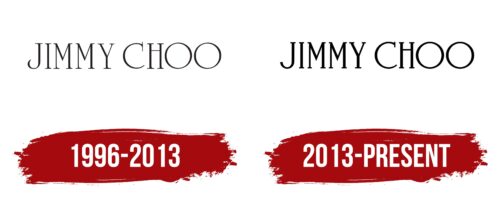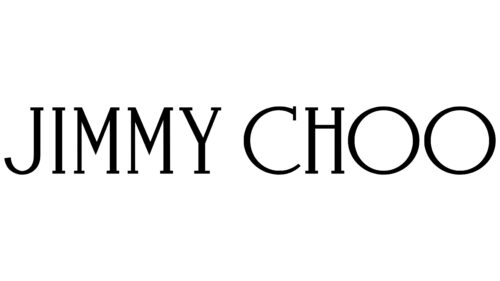The Jimmy Choo logo vividly and accurately reflects the brand’s popularity, embodying its commitment to tradition and constant drive for growth. This symbol also conveys the professionalism of its employees and the high quality of all its products. Every element of the logo, like every product from the brand, is distinguished by beauty and elegance.
The minimalist, neatly aligned letters draw attention and are easy to read. They evoke images of Jimmy Choo’s best offerings in the audience, reinforcing associations with sophistication and luxury. The logo does not aim to be creative or unusual, giving it a sense of seriousness and a classic look highlighting the brand’s prestige. It aligns perfectly with modern trends while remaining committed to timeless values.
A classic palette dominates the brand identity, creating a subtle play of contrasts: on a clean white background, sleek, slightly elongated letters in a dark shade stand out clearly. This harmonious balance of simplicity and refinement enhances the feeling of elegance and sophistication for which the brand is renowned.
Jimmy Choo: Brand overview
The Jimmy Choo story began in London in 1986. Born into a family of shoemakers, Jimmy Choo is a talented Malaysian shoe designer who set up his first studio in Hackney, East London. He honed his craft while attending the London College of Fashion, and his unique style and attention to detail quickly attracted the London fashion elite.
Early in his career, Jimmy Choo created custom shoes for a small group of clients, including members of the British royal family. His skill soon gained recognition, leading to collaborations with well-known fashion designers who featured his shoes on their runway shows.
In 1996, the company’s direction changed when Jimmy Choo partnered with Tamara Mellon, the accessories editor at British Vogue. Seeing the potential in his work, Mellon proposed starting a luxury ready-to-wear shoe brand. With financial backing from her father, a co-founder of Vidal Sassoon, they launched the luxury brand.
That same year, the first boutique opened on Motcombe Street in Belgravia, a prestigious London neighborhood. It quickly became popular with fashionable customers seeking high-end shoes. The business soon expanded, opening stores in other exclusive London locations.
The company’s profile skyrocketed in the late 1990s when its shoes appeared on Hollywood red carpets. Celebrities like Sarah Jessica Parker, known for Sex and the City, helped increase the brand’s appeal, making it synonymous with luxury and glamour in the footwear industry.
2001, the company expanded its product line by introducing bags and accessories. This move helped the business grow from a niche shoe company into a full luxury accessories brand.
In 2004, the brand reached another milestone by launching its first eyewear collection in partnership with the Safilo Group, further solidifying its presence in luxury fashion.
In 2007, the company’s ownership significantly changed. The founder sold his stake in the business, retaining only the right to use his name for certain projects. Tamara Mellon remained as the brand’s president and creative director.
In 2009, the brand continued its expansion by launching its first men’s shoe collection and debuting its first fragrance, Jimmy Choo Perfume, in partnership with Inter Parfums SA.
In 2011, the European luxury goods group Labelux acquired the brand, opening the door for further growth and development.
The Made-to-Order line, introduced in 2013, allowed customers to design personalized shoes, reviving the company’s tradition of bespoke craftsmanship that had attracted loyal fans from the start.
2014, the company went public, listing its shares on the London Stock Exchange. It was one of the fashion industry’s most successful IPOs that year.
In 2016, the business celebrated its 20th anniversary by releasing a special collection inspired by iconic shoe designs.
Another major event occurred in 2017 when the American company Michael Kors Holdings Limited (later renamed Capri Holdings) purchased the business for £896 million. This acquisition provided new resources for the brand’s growth while preserving its legacy.
In 2018, the company launched a new bridal shoe collection that became popular with brides worldwide. That same year, the business expanded further by introducing its first jewelry line.
In 2019, the brand ventured into a new market by releasing a line of athletic shoes, combining its signature glamorous style with the comfort and practicality of sports footwear.
During 2020 and 2021, the company adapted to changing times by strengthening its digital marketing and e-commerce strategies and enhancing its online presence.
In 2022, as the business celebrated its 26th anniversary, it remained a top global name in luxury shoes and accessories, continuing to expand its reach by opening new locations in key fashion capitals.
By 2023, the company had firmly established itself as a luxury brand known for its glamorous style and exceptional craftsmanship. The business stayed true to its roots in high-end footwear while pushing forward with innovation in design and marketing.
Over the years, the brand has evolved from a small London workshop into a globally recognized luxury footwear and accessory company. Despite changes in ownership and leadership, it has maintained its identity and remains a symbol of luxury and style in the fashion world.
Meaning and History
What is Jimmy Choo?
This luxury fashion house revolutionized the world of accessories and footwear. The brand is known for its brilliant and sometimes bold designs, becoming essential to red-carpet looks and fashionistas’ wardrobes worldwide. Its shoes feature elegant designs, high heels, and impeccable craftsmanship, often adorned with vibrant patterns or eye-catching decorative elements. The brand has also expanded its product range to include wallets, sunglasses, and perfumes, all marked by a signature elegance and sophistication. Continuing to push the boundaries of design, the company creates footwear that serves a functional purpose and is a work of art while maintaining a commitment to traditional manufacturing methods.
1996 – 2013
Initially, the Jimmy Choo brand positioned itself as a manufacturer of high-quality footwear whose products stood out noticeably among competitors due to their superior quality and unique style. The company was founded in the early 1980s, opening its first store in 1987. The first logo, however, was presented almost a decade later, in 1996, coinciding with the brand’s official registration.
A mystical beauty characterized the brand identity of that time. Using an original font, an elegant and memorable logo was created. Although it consisted of only two words, they spoke louder than many others. The first and last names of the brand’s founder formed a unique name, which, over time, became a symbol of high style. Jimmy Choo shoes, frequently worn in public by Princess Diana, brought the brand worldwide fame. Therefore, the logo could not be overly playful or fanciful—it reflected status and quality, serving as a purely informative element.
On a white background, the black letters appeared airy yet radiated dynamism. The rounded elements of the letters, along with graceful serifs, represented a successful combination of styles from different eras. The two “O” letters at the end of the second word subtly hinted at infinity. The precise edges and strokes of the logo drew attention and sparked interest. This logo, placed on all types of the brand’s products, lasted for almost two decades, leaving an indelible mark on the history of Jimmy Choo.
2013 – today
A new logo was introduced in 2013, along with updates to the brand’s strategic directions. This logo became a striking transformation of the previous version, retaining its key features but with more expressive graphics and symbolism. The brand name remained central, but the letters gained sharp outlines through bold black font. The characters were aligned in a single horizontal line with minimal spacing, giving the logo a strict and presentable appearance. It could be said that these two well-known words truly “shined.” Thanks to this update, the rebranding was considered very successful, and the new logo received many positive reviews, marking a significant step in strengthening the brand’s reputation.
Like many years ago, “Jimmy Choo ” again drew attention. The exclusive premium products began to see even higher demand. The logo, consisting of nine capital letters, conveyed reliability and high competitiveness. It contained no additional elements—drawings, symbols, or graphics—yet maintained its uniqueness and maximum presentability. The serifs on vowels and consonants added sophistication and emphasized the brand’s refined style.






